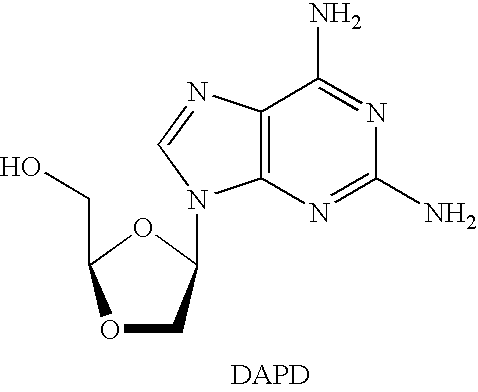N4-acylcytosine-1,3-dioxolane nucleosides for treatment of viral infections
- Summary
- Abstract
- Description
- Claims
- Application Information
AI Technical Summary
Benefits of technology
Problems solved by technology
Method used
Image
Examples
example 1
General Process for the Preparation of 1,3-DioxolaneIntermediate(i)
[0913]The 1,3-dioxolane intermediate (i) of the present invention can be synthesized according to U.S. Pat. No. 5,041,449, filed Jun. 29, 1990; U.S. Pat. No. 5,270,315, filed Mar. 7, 1991 (“2-Substituted-4-substituted-1,3-dioxolanes, synthesis and use thereof”); PCT application CA 92 / 00209, filed May 20, 1992; U.S. Pat. No. 5,756,706, filed May 13, 1994; U.S. Pat. No. 5,744,596, filed Jun. 5, 1995 (“Processes for diastereoselective synthesis of nucleosides”); PCT Application CA 94 / 00311, filed Jun. 7, 1994; U.S. Pat. No. 5,763,606, filed Feb. 2, 1995 (“Stereoselective synthesis of nucleoside analogues using bicyclic intermediate”); U.S. Patent Application 60 / 119,756, filed Feb. 11, 1999; U.S. Patent Application 60 / 119,885, filed Feb. 12, 1999; PCT Application CA 00 / 00144, filed Feb. 11, 2000; U.S. patent application Ser. No. 09 / 890,283, filed Feb. 11, 2000 (Stereoselective Synthesis Of Nucleoside Analogues); U.S. Pat...
example 2
General Process for Acylation of 1,3-Dioxolane
[0915]The 1,3-dioxolane intermediate (i) is protected at the 5′-hydroxyl with any known method known in the art. The protected 1,3-dioxolane (ii) is then acylated and deprotected to form the N4-acylcytosine-1,3-dixolane nucleoside of formula (iv). See Scheme 1.
Wherein are R1 is hydrogen or F; P is an oxygen protecting group; and R2 is chosen from alkyl, alkenyl, alkynyl, cycloalkyl, aminoalkyl, hydroxyalkyl, haloalkyl, thioalkyl, aryl, heteroaryl, and C6H4R6 where R6 is chosen from halogen (F, Cl, Br, I), CN, CF3, N3, NO2, alkyl, haloalkyl, aminoalkyl, alkoxy, thioalkyl, alkenyl, alkynyl, and aryl.
example 3
β-D-5-fluoro-N4-(4-iodobenzoyl)cytidine-1′,3′-dioxolane (vi)
[0916]To a solution of (ii) and DMAP in anhydrous CH2Cl2 and Et3N at 0° C. was added 4-iodobenzoyl chloride. The reaction mixture was stirred at 0° C. for 30 min, then at room temperature for another 3 h. After removal of the solvent by evaporation, the residue was mixed with THF, and TBAF was added. After stirring for 2 h at room temperature, the solvent was evaporated, and the residue was purified by flash chromatography on silica gel cluting with CH2Cl2 / MeOH (96:4) to give, after recrystallization from CH2Cl2 / hexane, the title compound vi as a yellow powder.
PUM
| Property | Measurement | Unit |
|---|---|---|
| Structure | aaaaa | aaaaa |
Abstract
Description
Claims
Application Information
 Login to View More
Login to View More - R&D
- Intellectual Property
- Life Sciences
- Materials
- Tech Scout
- Unparalleled Data Quality
- Higher Quality Content
- 60% Fewer Hallucinations
Browse by: Latest US Patents, China's latest patents, Technical Efficacy Thesaurus, Application Domain, Technology Topic, Popular Technical Reports.
© 2025 PatSnap. All rights reserved.Legal|Privacy policy|Modern Slavery Act Transparency Statement|Sitemap|About US| Contact US: help@patsnap.com



